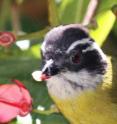Flower's bellows organ blasts pollen at bird pollinators
Related images
(click to enlarge)
A small tree or shrub found in mountainous Central and South American rainforests has a most unusual relationship with the birds that pollinate its flowers, according to a study reported in the Cell Press journal Current Biology on July 3. The plant known as Axinaea offers up its male reproductive organs as a tempting and nutritious food source for the birds. As the birds seize those bulbous stamens with their beaks, they are blasted with pollen by the flowers' complex "bellows" organs. The birds then deliver that pollen to receptive female floral organs as they forage on. "This unique and highly complex pollination system is completely new to science and provides another example of the intricate relationships that have evolved between flowers and their pollinators," says Agnes Dellinger of the University of Vienna. "The majority of bird-pollinated flowers offer nectar as a reward, and in the rare known cases involving food bodies, these reward tissues are restricted to the outer, sterile floral organs and are never found on reproductive organs."
Food bodies situated on male reproductive organs are otherwise only known from beetle-pollinated flowers, Dellinger adds. There is no other known example among plants of such a precise and anatomically distinct bellows organ.
Axinaea flowers appear in clusters of a few to more than 20 flowers, with pink, red, yellow, or orange petals that usually don't open completely. The stamens of those flowers stand out based on their contrasting colors and conspicuous, bulbous appendages. Something else about the stamens also piqued the researchers' curiosity: one or more of these stamens was almost always found missing in the flowers the researchers observed in the field or on herbarium specimens.
The researchers learned what had happened to those stamens -- and just how remarkably unusual Axinaea flowers actually are -- through a combination of pollination experiments, video monitoring, and detailed analyses of stamen structure and composition. They have observed multiple bird species, mostly tanagers, enjoying Axinaea food bodies and acting as pollinators in the process.
The findings may hold general lessons about the evolution of plants and their pollinators, the researchers say, noting that the vast majority of Axinaea's close relatives depend on bees for pollination.
"Only about 100 of the 5,000 or so species in the family Melastomataceae are known to produce nectar and to be pollinated by other insects or vertebrates," says Jürg Schönenberger, senior author of the study, also at the University of Vienna. "In the evolution of these species, including Axinaea, pollinator shifts in combination with changes in the floral morphology must have occurred."
Those evolutionary shifts may be related in part to growth at higher elevations, a pattern that would seem to support an earlier idea that birds may be more-efficient pollinators than bees at higher altitudes. The researchers say they now plan to study such pollinator shifts and their connection to ecogeographical changes, such as the uplift of the Andes Mountains, in greater detail.
Source: Cell Press
Other sources
- Flower's bellows organ blasts pollen at bird pollinatorsfrom Science DailyFri, 4 Jul 2014, 1:02:01 UTC
- Exploding flower blasts birds with pollenfrom Science NOWThu, 3 Jul 2014, 16:30:19 UTC
- Flower's bellows organ blasts pollen at bird pollinatorsfrom PhysorgThu, 3 Jul 2014, 16:00:54 UTC

